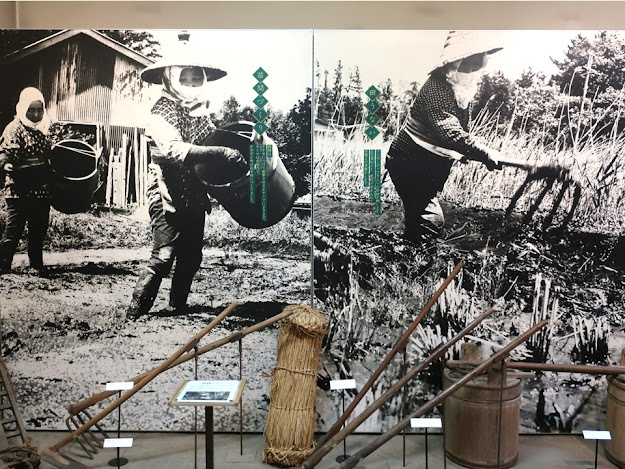From Nikko to Niigata in deep mountains
日光から新潟への山中の旅
Letter 11 FUJIHARA, June 24
Isabella went to northern mountainous area.
She found a gentleman there, “a decent-looking middle-aged man lying on his
chest in the verandah, raised on his elbows, and intently reading a book, ---". I was surprised that someone
enjoyed the fun of knowledge in deep mountains. She hired horses or mares in
poor countryside and moved north while admiring the view of Kinu River.
イザベラは、日光を立ち、鬼怒川から田島、会津へと向かう。日光からの馬が女性の馬子とともに帰った後、入った家では、上品な中年の男がベランダで熱心に本を読んでいたという。相当な山奥でも本があり、本を見る知の悦びがある。イザベラは、貧しい田舎で馬やロバを手配し、鬼怒川の光景を愛でながら、北に進む。
Her sketch below shocked me so much. Japanese
farmers didn’t wear almost anything in summer and wore just cloth in winter. I
cannot believe! I saw a lot of exhibits of farmer’s outfits as I attached below
her sketch. I need further investigation.
 |
Outfits
in summer and winter by Isabella
夏と冬の服装/イザベラのスケッチ |
 |
| Farmer’s outfits @ Ichikawa history museum、市川歴史博物館 |
当時の日本の男は、夏はほぼ何も身に着けず、冬も布を巻きつけただけ、というスケッチが残されているが、本当だろうか。他の資料館で見た絵や展示品では絣の着物を着ている。鹿鳴館の時代なのにショックである。
Letter 12 KURUMATOGE June 30.
She reached Kayasima (Kawashima?) one week
later after leaving Nikko. She was so tired with going over the pass between
Tochigi and Fukushima prefecture, so she stayed at an inn in a small village
which consisted of 57 houses. She wrote “The yadoya (inn) was simply awful.”
日光を出て一週間となる。栃木と福島の境の峠越え(山王峠)で疲れてしまったため、イザベラは、やむなくなく、カヤシマという57軒の家がある小さな村の宿に泊まる。ひどい宿屋であったそうだ。
Villagers had a festival on the day.
She wrote “At the end of the rice planting there is a holiday for two days,
when many offerings are made to Inari,
the god of rice farmers; and holiday-makers
kept up their revel all night, and drums, stationary and peripatetic, were
constantly beaten.” Rice planting was a hard work because they must bend their
backs. Moreover, they must finish it at once, so they work together. That’s why
Japanese farmers have a "Sanaburi" party after rice planting. It is good to refresh their mind. I think it is a good practice, although Isabella couldn’t sleep well.
 |
| Rice planting @ Hitachi City Museum、日立市郷土博物館 |
丁度、田植後の二日間の休日と重なっており、村は盛り上がっていた。田植えの後の「さなぶり」だ。イザベラは、holiday-makersが夜通しでお祭り騒ぎをしていると書いている。ということで、眠りは妨げられた。稲作は、田植、稲刈りが忙しいが、その後の宴会はメリハリがあって良いと思う。休みを取れる。
She also mentioned; Farmers didn’t
put on underwear and they didn’t wash clothes. Their houses were poorly
ventilated and dirty. Those circumstances aged farmers rapidly. I have driven this route before; it is actually deep mountains.
Isabella stayed at Oouchi-shuku
which is a famous tourist spot because many old houses still remain. The inn
Minoya where she stayed remains and we can visit the room in which she slept.
また、農民たちは下着を着ないし服も洗わない、家の風通しも悪く不潔であること、農民が老けて見える事が記載されている。車で、鬼怒川から田島に抜けたことがあるが、この辺りは相当な山中だ。イザベラは大内宿に泊まり、会津へと北上して行く。
 |
| Oouchi-shuku、大内宿 |
 |
Isabella
stayed at this room in Minoya
美濃屋でイザベラが泊まった部屋*1
|
Letter 14 KURUMATOGE, June 30.
More than one thousand people rushed to the inn
to see her so policemen guarded her, she wrote. She went west on Wakamatu
kaidou highway along Agano River which goes to the Sea of Japan.
Kurumatoge, which is the tittle of this letter, is the name of the pass and
she stayed at the inn there.
会津高田や坂下では、イザベラを見ようとする1000人を超える人たちが宿屋に押し寄せた。そんなこともあったが、イザベラは阿賀野川に沿った若松街道を日本海へと向かっていく。車峠は、会津野沢の先の峠で、峠の宿に泊まる。
LETTER 14 TSUGAWA, July 2.
 |
| Outskirts
of Tsugawa、津川の郊外*1 |
Isabella stayed at Tsugawa which is beside
Agano River, and she looked back on the people and houses which she saw in the mountains
between Nikko and Tsugawa. She mentioned Takarazawa and Sikaiyama, but I couldn’t
believe such terrible state of living just 140 yeas ago. She said the lives
were much different from those of Nikko and so on.
She wrote; The villages of that district must, I think have reached the lowest
abyss of filthiness in Hozawa and Saikaiyama. Fowls, dogs, horses, and
people herded together in shed ---. No young boy wore any clothing. Few of the
men wore anything but the maro, the women were unclothed to their waists and
such clothing as they had was very dirty, ---. I wonder how they enjoyed their
lives even in such a terrible condition. On the other hand, the rail way linked
Tokyo and Yokohama, and it also linked Ootsu and Kobe. I can say that the lifestyles varied very much depending on the regions.
イザベラは阿賀野川のほとりの津川で、日光から津川までの山中での人や家の様子を回想し、津川近くの宝沢とさいかい山の様子を述べる。すでに明治に入っているのに、そんなにひどい暮らしがあったのかと思う。日光などとは様子が違うと書かれている。イザベラは、宝沢やさいかい山の暮らしは最低レベルだと書いている。家禽も犬も馬も人も一緒に小屋に住んでいるし、子供たちはまっ裸、男は褌しかしていない者もいるし、女は汚い腰巻以外身に着けていない。こんな生活レベルでも楽しみがあったのだろうか。東京横浜間と大津神戸間には鉄道があったのだから、地域による差が大きかったということだ。
By the way, Tsugawa was a riverside port town
to Nigata which is the big town on the Sea of Japan coast. She ate fish and
wrote “A slice of fresh salmon has been produced, and I think I never tasted anything so delicious.” I think this was
the first time when she praised Japanese food. Then, she went to Nigata by
ship.
津川は、新潟と船でつながっている街だ。当時も3000人の人が居たという。イザベラは、鮭を食べて初めて日本の食事に美味しいという。そして舟で新潟に向かう。
LETTER 15 NIIGATA, July 4.
She enjoyed the river cruise to Niigata, “I enjoyed every hour of the day. It was
luxury to drop quietly down the stream, the air was delicious, and, having
heard nothing of it, the beauty of Tsugawa came upon me as a pleasant surprise.”
The boat was 45 feet long and she enjoyed “running the rapids of the Tsugawa”
on it. It must be fun for Japanese travelers and the locals.
イザベラは川下りを楽しんだ。14mの小さな舟だが、急流下りも楽しんだようだ。船旅は当時の日本人たちのとっても楽しかったはずだ。
Reference;
Agano River boat cruise, the newesr boat is named “Isabella Bird“.
https://aganosato.com/course/
阿賀野川ライン舟下りの屋形船。最新のジェット船はイザベラバードと名付けられている。
She arrived at Niigata around 3pm and she looked
at restaurants beside the river. She wrote “Tea-houses with many balconies
studded the river-side, and pleasure-parties were enjoying themselves with
geishas and sake, but, on the whole, the water-side street are shabby ---“.
Mr. & Mrs. Fyson took her in. It was 247
miles journey from Nikko to Niigata, she felt relieved. She spent over a week in
Niigata and she wrote a lot about food, but this is omitted in web edition unfortunately.
3時ごろには新潟に入るが、川岸には複数の茶屋が立ち、川床では芸者を上げて宴会をしていたという。新潟では、Fyson夫妻の家に迎えられほっとする。日光から新潟まで、247マイルの旅となる。新潟には一週間滞在する。(完訳には、食事のことなど詳しく書かれているが、英文にないので残念)
 |
| Niigata city、今の新潟*1 |
Previous
post (Comfortable days in Nikko):
Next
post (From Niigata to Akita via Yamagata):
There are 12 articles about Isabella's travel in Japan. The first page:
イザベラバードの旅は全12ページの記事です。最初の記事は上記のURLです。


Comments
Post a Comment